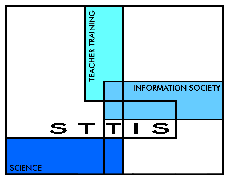Guide
 Contents Contents
|
Notes
on Section B Learning about the innovation
The main aims of this section are:
-
To apply the ideas of ‘energy transformation’ and ‘energy transfer’ approaches
and consider the merits and difficulties of each.
-
To clarify some important scientific ideas related to energy.
-
To learn about key ideas of the ‘Energy and Change’ materials.
-
To carry out some of the ‘Energy and Change’ activities using abstract
pictures.
-
To consider examples of the work of pupils doing these activities.
Notes on the activities follow:
This activity is relevant to the ‘Energy transfers’ innovation, and could
be omitted if the focus is on ‘Energy and Change’. An ‘energy circus’ is
typically used to introduce ‘forms of energy’ to pupils, and teachers begin
the activity by doing the circus as pupils would do it. They are then asked
to consider the advantages and disadvantages about the ‘forms of energy’
approach. Background information about this can be found in Briefing
Sheet 2 ‘Transferring vs transforming energy’.
This activity is relevant to the ‘Energy transfers’ innovation, and could
be omitted if the focus is on ‘Energy and Change’. In this activity, teachers
are asked to look at the ‘energy circus’ but from the point f view of an
‘energy transfer’ approach. As in Activity B1, they are asked to consider
the advantages and disadvantages of the approach. Background information
about this can be found in Briefing Sheet 2 ‘Transferring
vs transforming energy’ and Briefing Sheet
3 ‘Energy – why learn about it?’.
This activity is relevant to the ‘Energy transfers’ innovation, but it
could also be included as a useful introductory activity if the focus was
one Energy and Change’. The first part of the activity is about comparing
the two approaches from Activities A1 and A2; It is the energy transfer
approach which is used in the ‘Energy and Change’ materials. The second
part of the activity is intended to clarify teachers’ scientific ideas
about energy. Useful background information on both these aspects can be
found in Briefing Sheet 3 ‘Energy - why learn
about it?’.
This is the first activity related specifically to the ‘Energy and Change’
innovation. Background information about this approach can be found in
Briefing Sheet 4 ‘Introduction to Energy and Change
materials’. It aims to introduce some initial ideas about energy flows
and about how they are represented using the abstract pictures. It should
be seen essentially as an activity to learn some basic ideas to be used
later, and it would be helpful to move on to a later activity where the
ideas are applied before engaging in more detailed discussions about the
usefulness of the approach.
This is the second activity related specifically to the ‘Energy and Change’
innovation. It follows up the work in Activity B4, by applying the ideas
introduced in that activity to some more complex situations involving insulation.
Teachers may be unconvinced about the possibility of using such an approach
with pupils; they may think it is too ‘difficult’ or ‘demanding’. This
is an important discussion to have at this point, and for this reason some
extracts of pupil discussion about this activity are given. (See Briefing
Sheet 6 ‘Pupils’ understanding: Insulation’ for information about this.)
This is the third activity related specifically to the ‘Energy and Change’
innovation. It focuses on spontaneous and non-spontaneous change, and how
these are represented. The notion of one change ‘driving’ another is central
to the ‘Energy and Change’ project, and so this activity captures the essence
of the thinking behind it. The following two activities (B7 and B8) take
the ideas further by applying them to a range of more complex situations.
Again, this is an apparently difficult idea, and may provoke discussion
amongst teachers. Examples of pupil work are given and these are discussed
further in Briefing Sheet 7 ‘Pupils’ understanding:
Things that ‘just happen’ and things that don’t’.
This is the fourth activity related specifically to the ‘Energy and Change’
innovation. Much of the work here is concerned with mechanical systems,
but the main reason for including it in this workshop is that it is built
on subsequently in Activity B8, which considers what drives chemical change.
The final part of the activity asks teachers to think about these ideas
in relation to their existing practice. If they are continuing to work
on the following activity it may be better to treat both activities together
in considering how they could use these ideas in the curriculum.
This is the final activity related specifically to the ‘Energy and Change’
innovation. It brings together many of the ideas introduced in earlier
activities such as the representation of energy flows, temperature differences,
the ideas about spontaneous change and how one change can drive another,
and about the notion of energy stored in springs (here applied to ‘chemical
springs’). This activity requires thorough planning by the trainer to talk
through the OHTs and how they relate to each other. Examples of pupil discussion
are given, and further information can be found in Briefing
Sheet 8 ‘Pupils’ understanding: Fuels and food’. |

 Teaching about energy
Teaching about energy

